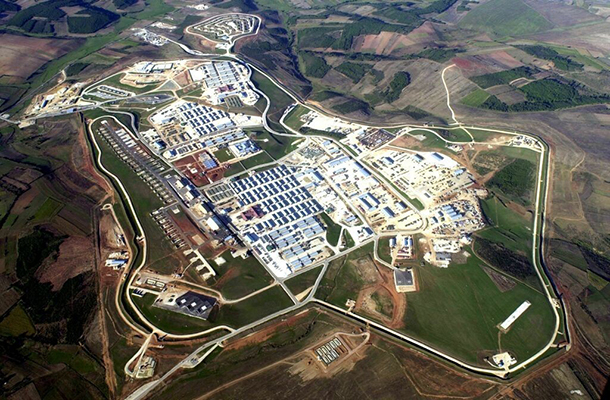
During a Sensitive Site Exploitation (SSE) mission in the Zhawar Kili area of Eastern Afghanistan – an Osama Bin Laden propaganda poster supposedly found by members of a US Navy (USN) Seal Team (Image Source: Britannica)
Dr Can Erimtan
21st Century Wire
President Biden has now taken it upon himself to end “America’s longest occupation,” as expressed by the progressive talk show host Thom Hartmann. While he was Vice President, his then-boss Barack Obama actually attempted to retreat from the Hindu Kush, even making bold claims at the time: The deadline for the “normalization of our presence in Afghanistan remains the end of 2016. That hasn’t changed. Our transition out of a combat role has not changed.”
Alas, that was not to be… nor was he able to keep the promise he made ‘on his third day in office,’ back in 2009: President Obama ordered the detention facilities at Guantanamo to be closed “as soon as practicable, and no later than one year from the date of this order.” But facts on the ground can be stubborn things and more often than not impossible to change or re-arrange.
Nacht und Nebel: Abandoning the Mission in the Hindu Kush
That was then, and this is now: about twelve and a half years later. The BBC reported the other day that the “US military left Bagram Airfield – its key base in Afghanistan – in the dead of night without notifying the Afghans, the base’s new commander said” (7 July 2021). About a fortnight earlier, President Biden said that “Afghans are going to have to decide their future, what they want,” adding that the “senseless violence has to stop” (25 June 2021).
This all might give the impression that the dynamic duo of Obama and Biden are the main culprits that ordered American soldiers to go fight in the Hindu Kush. Instead, another odd couple really bears full responsibility: namely, Bill Clinton and George W. Bush, as “the invasion of the Hindu Kush . . . was [actually] the brainchild of a number of experts during a ‘4-day [mid-July 2001] Berlin meeting carrying the heading ‘Brainstorming on Afghanistan’ and [that] was apparently the outcome of the Clinton administration’s concerns over Osama bin Laden,’ going back to the 1998 attacks on two US embassies in Africa – in Dar es Salaam and Nairobi. But it was down to 9/11 and George W. Bush to ignite the Afghan powder keg, leading to a conflagration subsequently deftly and somewhat ineptly handled by the Nobel Peace Prize-wielding Barack Obama,” and then by his successor Donald J, Trump, to now finally end in a swift and sudden retreat overseen by the current POTUS.
In fact, Joe Biden has now decided to stick to “America’s commitment . . . to finally withdraw from Afghanistan,” a deal that had been “negotiated between the Trump administration and the Taliban,” as relayed by the columnist and cartoonist Ted Rall. And, the U.S. President has set himself a symbolic “September 11, 2021 deadline for [this supposedly final] withdrawal of the last U.S. troops.” Arguably, the iconic 9/11 attacks in 2001 spurred Bush, Jr. to invade the Hindu Kush in order to capture Osama bin Laden, the alleged mastermind behind the audacious 2001 attacks on America – Bush presented Bin Laden as the alleged brains behind the realization of a “new Pearl Harbor,” as presciently coined in the Project for the New American Century (PNAC, 1997-2006)’s seminal report, Rebuilding America’s Defences: strategy, forces and resources for a new century:
[T]he process of [the] transformation [(of the) Department of Defense (to) move
more aggressively to experiment with new technologies and operational
concepts] . . . is likely to be a long one, absent some catastrophic and catalyzing
event – like a new Pearl Harbor . . . Any serious effort at transformation must occur
within the larger framework of U.S. national security strategy, military missions and
defense budgets.
And 9/11 was the “new Pearl Harbor” that was needed, not just to transform the Pentagon, but the whole of American society and the rest of the world as well. For, just like the original Pearl Harbor attack (7 December 1941) had ushered in America’s fight against Hitler, the Nazi movement and its allies, turning that European conflict into a veritable World War, 9/11 (11 September 2001) provided the impetus for the global War-on-Terror. This war’s first battleground was the Hindu Kush (7 October – 17 December 2001), but rather than hunt down Osama bin Laden supposedly hiding in the Tora Bora mountains before moving to Abbottabad in neighbouring Pakistan, together with “his extended family—wives, children and grandchildren” (early in 2006, apparently), the Bush administration quickly turned its attention to Iraq and Saddam Hussain (19-20 March 2003 being the dates of the actual invasion) – leaving Afghanistan in a state of constant terror and war for the next 20 years.
The always intrepid John Pilger put it like this: “On the morning of 12 September 2001, without any evidence of who the hijackers were, [then-Secretary of Defense Donald] Rumsfeld [1932-2021] demanded that the US attack Iraq.” Alas, the invasion of Iraq was temporarily postponed, because the then-Secretary of State Colin Powell persuaded Bush and Cheney (the gruesome twosome running the American show at the time, with the former taking the limelight and the latter, the decisions) that “public opinion has to be prepared before a move against Iraq is possible,” and as a result, Afghanistan was chosen as the softer option – the mere fact that Bin Laden happened to be there was merely fortuitous. The invasion of Iraq made Cheney and his corporate cohort extremely rich and ensured a second term for the gruesome twosome to run the show and consolidate Halliburton’s gains and profits – between 1995 and 2000, Cheney served as chairman of the board and CEO of the company, receiving a trifle $12.5m in salary, while holding $39m-worth of stock options. In Iraq, Halliburton obtained a huge number of no-bid contracts. The journalist David Rosenbaum relates matter-of-factly that “Halliburton’s business with the [U.S.] military has grown substantially since Mr. Bush and Mr. Cheney took office. The company rose to seventh-largest military contractor in 2003 from 22nd-largest in 2000.” Additionally, Rosenbaum divulges that, “since becoming vice president-elect,” Cheney “has received $1,997,525 from” Halliburton: $1,451,398 in a bonus deferred from 1999, the rest in deferred salary. And according to the investigative journalist and progressive author Pratap Chatterjee, Cheney was able to strike further lucrative gold deposits after joining Bush as nominal Vice President:
Cheney cashed in his remaining stock options gradually, starting with selling 100,000 Halliburton shares in May 2000, for an immediate profit of $3m. In 2005, Cheney exercised most of what remained of his Halliburton stock options for a $6.9m profit.
In spite of these lucrative outcomes of 11 September 2001, the morning of 12 September 2021 will arguably see the return of the once and future rulers of Afghanistan: the Taliban, who have been making steady gains since early May.
American Boots around the World: Establishing the American Empire
But Biden will have unburderned the American public-at-large of a big and troublesome worry, as American boots will have finally left the mountainous “Graveyard of Empire.”
Rather poetically, James Fergusson and Gerald Hughes remark that “over the centuries, the myth of Afghan invincibility [has been] reinforced as the greatest powers of their day – the Macedonians, the Mongols, the Mughals, the British, the Soviet Union and, most recently, the United States – [have] found their might rendered impotent” in the Hindu Kush. On the other hand, there are still many other locations around the globe where American boots continue to stomp around. In “nearly 800 military bases in more than 70 countries and territories abroad,” to be precise, as dryly stated by the sociologist, Dr David Vine. The geographical scope is breath-taking, from Italy to the Indian Ocean, from Japan to Honduras. Vine matter-of-factly states that “American military bases encircle the globe.” On the Fourth of July this year, Dr Vine tweeted: “Entering the 246th year in US history, and the US military is still at war . . . What will it take to turn the US away from war? What will we do to make the US a country dedicated to peace?”
The mere existence of these U.S. bases around the globe is nothing but the outcome of the so-called Truman Doctrine, formulated and promulgated in 1947. The U.S. State Department’s Office of the Historian, directed by Dr Adam Howard since 2019, explains that President Truman (1945-53) “effectively reoriented U.S. foreign policy, away from its usual stance of withdrawal from regional conflicts not directly involving the United States, to one of possible intervention in far away conflicts” – ‘possible’ interventions made feasible and practicable as a result of a global network of U.S. military bases.
This network of bases constitutes the main reason why some people sometimes like to talk about an American Empire – an empire unlike any other, such as the British or the Roman empires that were based on territorial acquisition and/or the imposition of colonial rule in faraway locations. Instead the American Empire is one based on economic gains and other strategic benefits accrued as a result of the ever-present threat of military force and coercion. This military component of the American enterprise is directed from the U.S. Central Command at the MacDill Air Force Base, in Tampa, Florida (aka CENTCOM). Additionally, there are ten more military command centres – from AFRICOM (located in Germany’s Stuttgart) over INDOPACOM (on Hawaii) to additional Functional Combatant Commands, such as the Special Operations Command SOCOM (in Florida) or CYBERCOM (in Maryland). This more than impressive military footprint controlled from these 11 nerve centres effectively ensures that the American Empire never gets short-changed (whatever President Trump may have been claiming about “trade imbalances” and “trade deficit” during the four years of his haphazard rule).

Aerial photo of Camp Bondsteel, KFOR, Task Force Falcon Public Affairs Office (2000)
Camp Bondsteel: Another Clinton Legacy
President Biden may very well have wanted to give the American (and global) public the impression that he is all about ending “America’s Forever Wars,” but as colourfully expressed by the Cato Institute’s Adjunct scholar John Glaser, the Woke-in-Chief is merely “playing hide the ball” with the hapless masses living throughout the U.S. and beyond. As I have pointed out quite some time ago, when it comes to “U.S. imperial policy” continuity always trumps change. Biden may now be appearing to dismantle one Clinton legacy in the form of the U.S. occupation of Afghanistan, but he seems quite content to continue an even older Clinton legacy: namely, Camp Bondsteel in Ferizaj, Kosovo (established in the context of the 1999 bombing campaign against Serbia). The “privately owned and operated” website Military Bases gives this potted though undated history and appraisal of Camp Bondsteel:
The base was constructed by the 94th Engineer Construction Battalion, in a tight collaboration with KBR (Kellogg, Brown and Root Corporation). As a matter of fact, KBR also owns the rights for this place, although it is a private company. The base [wa]s built in a hilly area, therefore in order to flatten the site, the workers had to “eliminate” two high hills. At the same time, the valley separating the hills had to be filled with various materials. The facilities on site are not among the best when it comes to the buildings and the overall site. Most of them are built of wood. There are also plenty of SEA (South East Asia) huts all over the camp. It is protected by a 2.5m high wall made out of earth . . . Able to host more than 7000 troops on site, Camp Bondsteel is currently the largest and widest base run by the United States of America in the Balkans
Incidentally, KBR is a subsidiary company owned by Halliburton and was thus also one of the big winners in the aftermath of the 2003 invasion of Iraq. Even more ominously, more than ten years ago now, the then-Council of Europe’s human rights envoy, Thomas Hammarberg (2006-12), described Bondsteel as a “smaller version of Guantánamo.” And now, President Biden seems set to continue the good work of his one-time boss in not closing down Gitmo and continuing the upkeep of its smaller brother in the Balkans – Camp Bondsteel.
9/12: The Once and Future Rulers of Afghanistan
Next month will mark the 20th anniversary of the 9/11 attacks and the formal end of America’s fight to protect women’s rights in Afghanistan. In an article I wrote on the ninth anniversary of the attacks (published in a now no longer extant Turkish newspaper), I suggested that George W. Bush may have had additional reasons for sending his soldiers into the Hindu Kush. Though at the time Bush (or Dubya, if you will) was regarded as the most mentally backward POTUS to sit in the Oval Office (little did people anticipate Donald J. Trump’s tenure), he had been more than aware of the country of Afghanistan and its potential:
[In] 1997, the Taliban had [namely] sent a delegation to Texas to talk about a possible lucrative pipeline passing through their territory. Then-Governor of Texas George W. Bush supported the Texas firm Unocal in its dealings with the Afghans. Subsequently, Unocal and its partners planned to build a 1,000-mile gas pipeline from resource-rich Turkmenistan to Multan in Pakistan, passing through the Taliban heartland of Kandahar.
During the Obama years, this pipeline project was expanded to include a 400-mile extension to India, giving rise to the acronym TAPI, indicative of the countries the project encompasses: Turkmenistan, Afghanistan, Pakistan and India. The ongoing insurgency in Afghanistan following 9/11 made the realization of the TAPI project all but impossible. But then, at the end of 2014, the Turkmen President Gurbanguli Berdymukhamedov came out saying that the construction of the much-vaunted pipeline will finally start in 2015. Alas, the continuing violence in the Hindu Kush seems to have delivered TAPI to the junk heap of history.
Writing last year, The Diplomat‘s managing editor Catherine Putz pointed out that “Afghan officials say laws on land acquisition for the [TAPI] project as it crosses Afghanistan have not been signed [yet], meaning the project’s timeline remains as foggy as ever.” Perhaps, following their presumed return to power on 9/12, the Taliban will finally cut through this Gordian Knot and ensure the completion of this important addition to Pipelineistan.
Whatever the case may be, the affairs of Afghanistan will by then supposedly no longer keep Joe Biden awake at night – he will still have the rest of the American Empire to worry about. While domestically, his new-found Woke identity will no doubt continue to divide opinions and make progressives hope for a new New Deal ushered in by a 21st century FDR.
***
21WIRE special contributor Dr. Can Erimtan is an independent historian and geo-political analyst who used to live in Istanbul. At present, he is in self-imposed exile from Turkey. He has a wide interest in the politics, history and culture of the Balkans, the greater Middle East, and the world beyond. He attended the VUB in Brussels and did his graduate work at the universities of Essex and Oxford. In Oxford, Erimtan was a member of Lady Margaret Hall and he obtained his doctorate in Modern History in 2002. His publications include the revisionist monograph “Ottomans Looking West?” as well as numerous scholarly articles. In Istanbul, Erimtan started publishing in the English language Turkish press, culminating in him becoming the Turkey Editor of the İstanbul Gazette. Subsequently, he commenced writing for RT Op-Edge, NEO, and finally, the 21st Century Wire. You can find him on Twitter at @TheErimtanAngle. Read Can’s archive here.
READ MORE NATO NEWS AT: 21st Century Wire NATO Files
SUPPORT OUR MEDIA PLATFORM – BECOME A MEMBER @21WIRE.TV















